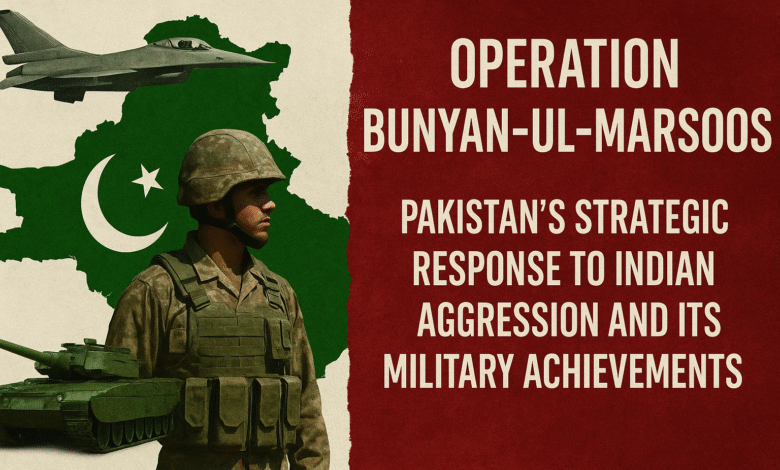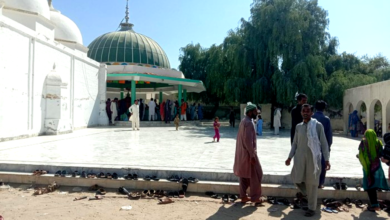
Operation Bunyan-ul-Marsoos: Pakistan’s Strategic Response to Indian Aggression and its Military Achievements
Operation Bunyan-ul-Marsoos is a military concept and narrative often associated with Pakistan’s retaliatory and defensive posture against Indian incursions, particularly in the context of modern hybrid warfare and counterterrorism campaigns. Though not officially detailed in open-source military doctrines, the term is increasingly used in political, defense, and media discourse within Pakistan as a symbolic representation of robust military preparedness and response, especially post-2019 tensions.
This article explores the context, implied structure, and the claimed achievements of Pakistan under the conceptual umbrella of Operation Bunyan-ul-Marsoos, primarily viewed as a psychological and strategic deterrent against Indian aggression.
Background and Context
The phrase “Bunyan-ul-Marsoos” translates roughly to “Solid Structure” or “Fortified Wall,” a reference from the Quran (Surah As-Saff, 61:4) used to symbolize unity, strength, and resolute defense. Pakistan has invoked this term in military and ideological frameworks to define a national resistance and coordinated strategy against foreign threats—particularly those from India.
The concept gained traction particularly after two landmark incidents:
- The Pulwama-Balakot conflict (2019)
- Heightened tensions in Kashmir post Article 370 abrogation by India
These events catalyzed the development of a more overt Pakistani posture, combining diplomacy, information warfare, and conventional readiness.
Strategic Goals of Operation Bunyan-ul-Marsoos
-
National Defense Coordination:
Aimed at unifying the tri-services (Army, Navy, and Air Force) under a singular doctrine of retaliation and deterrence. -
Countering Indian Surgical Strike Doctrine:
Pakistan sought to neutralize the narrative of “surgical strikes” by enhancing readiness and visibility of response capability. -
Information Warfare and Psychological Operations:
Elevating national morale and sending a deterrent message to India and international observers. -
Post-Balakot Retaliation – Operation Swift Retort:
Though separately named, this operation was part of the overarching retaliatory framework and is often linked with Bunyan-ul-Marsoos in ideology and execution.
Major Pakistani Achievements in the Framework of Bunyan-ul-Marsoos
1. Operation Swift Retort (February 27, 2019)
As a tactical element of the broader Bunyan-ul-Marsoos doctrine:
-
The Pakistan Air Force (PAF) launched precision strikes across the Line of Control (LoC) without crossing it.
-
PAF shot down two Indian aircraft (MiG-21 and allegedly a Su-30MKI), capturing Indian pilot Wing Commander Abhinandan Varthaman.
-
The operation restored the balance of deterrence post-Balakot and won global attention.
2. Strategic Messaging and Media Warfare
-
Pakistan used state and international media to present its version of events.
-
Highlighted the downing of Indian jets and humane treatment of the captured pilot.
-
Positioned itself as a responsible nuclear state acting in self-defense.
3. Defense Posture Strengthening in Kashmir
-
Enhanced military presence and vigilance along the LoC and Working Boundary.
-
Launched diplomatic counteroffensives to internationalize the Kashmir issue following India’s Article 370 move.
4. Civil-Military Unity & Internal Consolidation
-
Promoted a unified internal front, reducing dissent and highlighting national sovereignty.
-
Used Operation Bunyan-ul-Marsoos as a rallying symbol across political and religious spectra.
5. Technological and Tactical Evolution
-
Enhanced air defense networks, radar surveillance, and electronic warfare capacities.
-
Conducted military drills and war games simulating Indian aggression and rapid response scenarios.
Diplomatic Victories and International Engagement
-
UN and OIC involvement: Pakistan raised its voice on Indian actions in Kashmir through diplomatic channels.
-
Media and human rights narrative: Amplified reports of Indian human rights violations, attempting to shift global opinion.
-
Avoided escalation: Despite conflict, Pakistan was able to avoid full-scale war, showcasing strategic restraint.
Criticism and Controversy
While Pakistan celebrates these operations as significant achievements, critics argue that:
-
The actual long-term impact on India’s policy, especially in Kashmir, remains limited.
-
Military-centric responses may overshadow economic and political reforms.
-
The operation is more symbolic and ideological than documented in formal military doctrine.
Conclusion
Operation Bunyan-ul-Marsoos stands as a symbolic doctrine of national resilience and tactical deterrence against Indian aggression. It represents more than a single operation—it embodies Pakistan’s evolving hybrid warfare strategy, showcasing its readiness to defend territorial integrity, counter perceived Indian dominance, and assert its geopolitical stance.
Whether as a psychological shield, diplomatic strategy, or military framework, Bunyan-ul-Marsoos has come to define a new phase in South Asian deterrence dynamics, with Pakistan presenting itself as a firm and reactive regional power.







